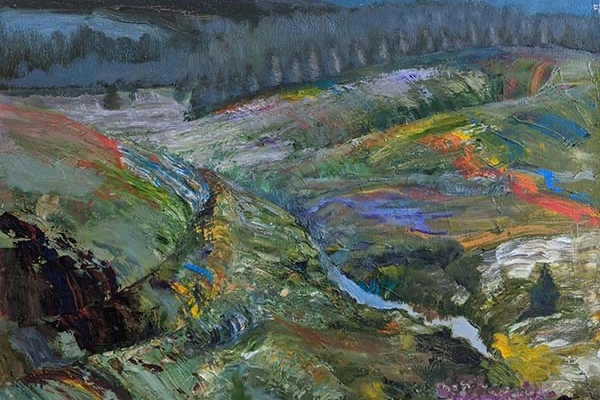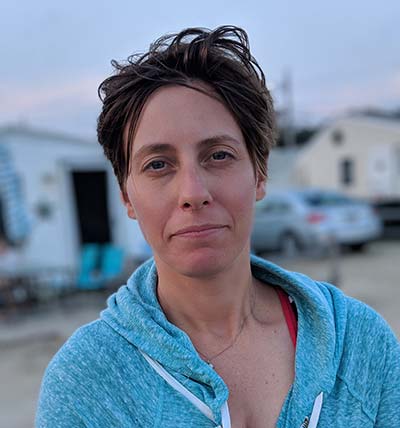 Caitlin Hurd, who was born in the suburbs of Boston, has worked on several public art projects. Her artwork has been shown in more than thirty group and solo shows. She has also been featured in publications such as Hi-Fructose and the New York Post. She founded Spark Portrait, a portrait business in Easthampton, MA, and Artists Off Grid, an artist-in-residency program. She holds an MFA in Painting from the New York Academy of Art and a BFA in Furniture Design from the Minneapolis College of Art and Design. She studied computer animation at the Ringling School of Art and Design in Sarasota, FL. Her work appears in WTP Vol. VIII #6.
Caitlin Hurd, who was born in the suburbs of Boston, has worked on several public art projects. Her artwork has been shown in more than thirty group and solo shows. She has also been featured in publications such as Hi-Fructose and the New York Post. She founded Spark Portrait, a portrait business in Easthampton, MA, and Artists Off Grid, an artist-in-residency program. She holds an MFA in Painting from the New York Academy of Art and a BFA in Furniture Design from the Minneapolis College of Art and Design. She studied computer animation at the Ringling School of Art and Design in Sarasota, FL. Her work appears in WTP Vol. VIII #6.
Interview with Caitlin Hurd
By Jennifer Nelson, WTP Feature Writer
Nelson: In paintings such as “Sister Cat” and “Sleep on Your Toes,” humans and animals appear suspended, lending them a ghostly feel. How did you come to this surprising, but deeply affecting surrealism—if you would call it that?
Hurd: My painting process comes from a surrealist approach, where I don’t know what I am going to paint before it appears on my canvas. I paint one item at a time and when I am done I sit and stare at it and wait for my painting to tell me what’s on my mind. I had originally intended for “Sister Cat” to have a lot more cats, but after three were painted the idea of a floating young woman popped into my head. I then went out to find a theater harness and a long chain and a friend willing to let me hang her in the harness from the beam in my studio, wearing the dress I altered from the second-hand store so I could paint from life.
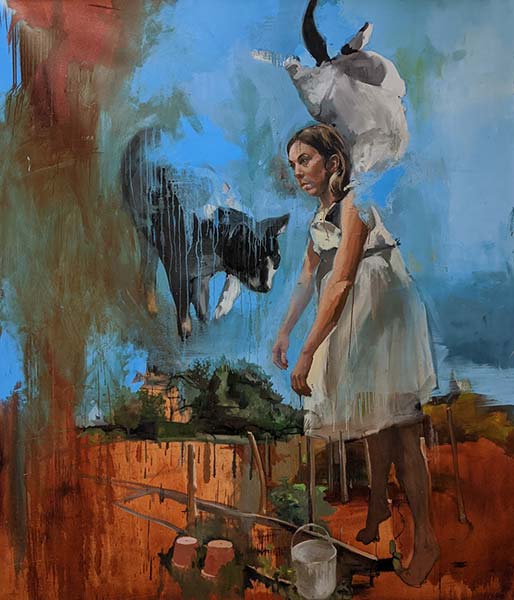
Nelson: You survived being run over by a car and spent a month in the hospital recuperating. How might have this accident informed your work as an artist?
Hurd: After my accident and the hospital, there was a long recovery at home, lots of physical therapy and doctors’ appointments and chronic pain. With all this, I could not escape the fact of how little control I had in life, and how everyone has an illusion of control over their own lives. Since my accident, in my work and my life, I try to find the beauty in being without control. I also learned about growth and renewal, as I had the experience of starting over in both my life and my career.
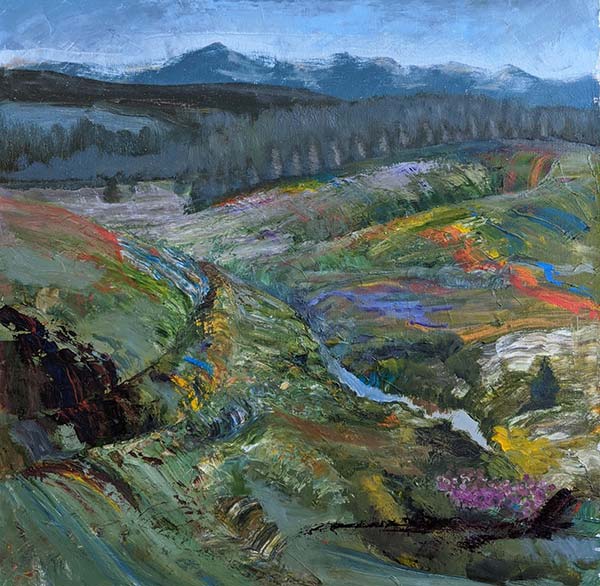
Nelson: Where do you get inspiration in such paintings as “Landscape 1,” and what turned you toward portraying nature, instead of people and animals?
Hurd: I think in most of my work I start by painting a landscape as a starting point. Like when I painted “Landscape 1” and most landscape paintings start off with plans to include people and/or animals. With some paintings, just when I am about to put more into the painting, the painting seems to be done at that point.

Nelson: How do you balance running a portrait business with creating your personal artwork? And how might one inform the other?
Hurd: Seriously painting portraits started when a good friend’s toddler died from a brick falling from the sky. The grief was unbearable and so I painted her portrait. It was cathartic for me. It was a way to be totally concentrated on my grief and once again be with a loss of control. There is no way to make sense of it for me or for her parents or family, but it was just there. I ended up giving this portrait to my friends and I saw how important and meaningful it was for them, as well. The way I see it, portraits are my personal artwork; they are two different avenues that start from the same place. A lot of my portrait clients are grieving parents and I relate to this population in a way that is similar to how I felt after my car accident: that no one has been through what I have, no one can beat me in suffering, and it gives me the right to do whatever I want to do. It’s not true of course, because everyone suffers in their own way, but it was a common thought that ran through my head. A portrait can provide a path forward through those thoughts and feelings, help you be with that loss of control, and let you see the place where you can live your life again.
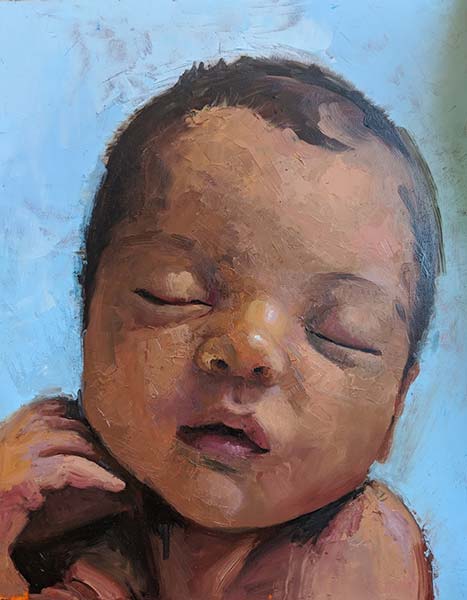
Nelson: What techniques did you use to create “Flying Animals,” a large mural in Manhattan, and what are the benefits and challenges of making public art?
Hurd: “Flying Animals” was a really exciting project for me because everything happened so quickly from applying to completion. I think the whole thing took a few months. Art Area Projects found me and asked me to apply. They helped me with everything from my application, to my budget, to hiring people to install the mural. In my studio I was so used to working on my own and making my own decisions. This public art process was a test on saying “Yes, I can do that” and not being 100% positive that I could. It was about trusting other people and their experience and working together with many people. Ayelet Aldouby from Art Area Projects was confident I could, and it was really fun working with so many different people with different jobs, all working for one large flying cow mural. I ended up painting the mural at one third scale in my studio, having it professionally photographed and then printed on vinyl, like what’s used for billboards. The mural was only supposed to be up for less than a year but it survived for eight years, through the construction of the Holiday Inn in the Financial District in Manhattan. Public art can take on a life of its own once it’s out in public. I watched as the mural suffered damage and repair, as construction signs and permits were attached to it, and as it was rearranged as pieces of the fencing were moved around. It was part of the city at that point, and no longer under my control.
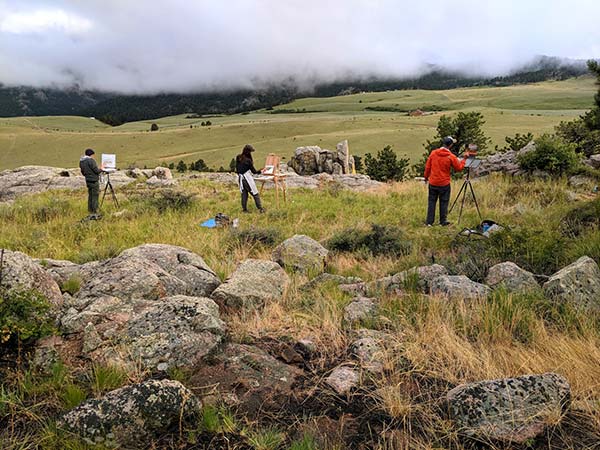
Credit: Charis Carmichael-Braun
Nelson: Can you tell us about founding Artists Off Grid, and what do you hope is gained from this residency program in the mountains of Larimer County, CO?
Hurd: Artists Off Grid all started with me wanting to be on this stunning land and not feeling safe to rough it without electricity, Wi-Fi, or running water. My mother-in-law Marilyn Ramming bought this beautiful piece of land to build a little house and retire on. In the midst of construction, she was driving and hit an icy patch on the road, her truck flipped and she was paralyzed. Building and living in her dream home on the rustic spot without electricity or running water was not possible for her. She asked that my husband and I do something with this land and to assess what we could possibly do, I needed to spend time there.
At first, I was thinking I would just invite a few friends to come and paint while I figured out what to do with a withering half-built house. My husband needed to stay home to work, so I brought my 4-year old along with me. I found a few great artists who wanted to join me and I was talking with my friend Dina Brodsky, who suggested I make this more than an artist’s retreat and find a gallery in Denver to show the work. I contacted Abend Gallery; they liked my concept and said Yes! The first year went so much better than I expected. It was a real disentanglement from technology and everyday chores. It’s true I had many new chores, like fetching water and bailing out my tent after a rainstorm but everything was done for basic survival except for painting. I learned to appreciate what I thought was normal as a luxury, like water, clean clothes, and my bed. I would have desires for a burger and think about it for days. I’d finally get one in town when I was there for water and discover a burger was not what I wanted, but just the comfort of normalcy. Discovering what I really needed and really wanted brought a whole new dimension to painting and the creative process. I am currently in the process of relocating Artists Off Grid to New England, and I’m very excited about the new ways it will take shape. Being off grid in New England is different than in Colorado, but I will continue to offer artists (and their families) an experience of exploring what is essential in life and in art.
Nelson: This year, you created small paintings in ink such as “Bear II.” Why did you switch mediums, and what are the advantages and challenges of using ink and creating small works?
Hurd: I’ve been having fun drawing lately, for sure. I think it started with logistics. I am someone who always wanted to paint small and make drawings at home. I wanted the freedom of being able to work anywhere, and pack light. In the past, small work was never as exciting to me as my big work but now, for some reason, I am enjoying it. With making large paintings I’ve always had to be in my studio. With drawing and small paintings I am less restricted by space and time. After my kid goes to bed, I usually have a few hours to work, making little drawings at home. Ink is far less forgiving than oil paint. I really have to be focused on what I am doing because each line matters and can’t be taken away, like with oil paint.
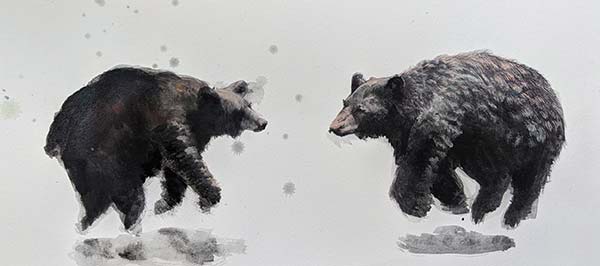
Nelson: From 2001 to 2004, you conducted mural painting workshops for high-risk youth in Brooklyn and Salem, MA. Can you talk about this experience, of teaching painting, drawing and sculpture to kindergarten to eighth graders?
Hurd: When I was at MCAD, I assisted on a special project with public artist Kinji Akagawa. He taught me all about giving kids their own voice and taking ownership of their space. Working on murals with kids was a rewarding job because it was always something that the kids needed for their sense of self and community. He taught me that public art is fundamentally about trusting in other people and trusting in the process.
Nelson: When did you first decide to pursue a career as an artist, and did studying computer animation at the Ringling School of Art and Design in Sarasota, Florida impact your decision?
Hurd: I always wanted to be an artist. Since I was a little kid, all I wanted to do was draw, paint, and make things. Art has always involved self-exploration and transformation for me. Computer animation probably would have provided me with a more stable career path, but that stability came at the cost of exploration and transformation. I was compelled to find an artistic process that lets me find out who I am in this world.
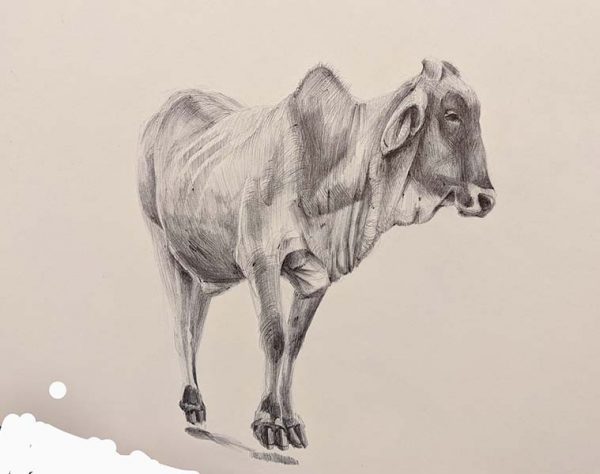
Copyright 2020 Woven Tale Press LLC. All Rights Reserved.

